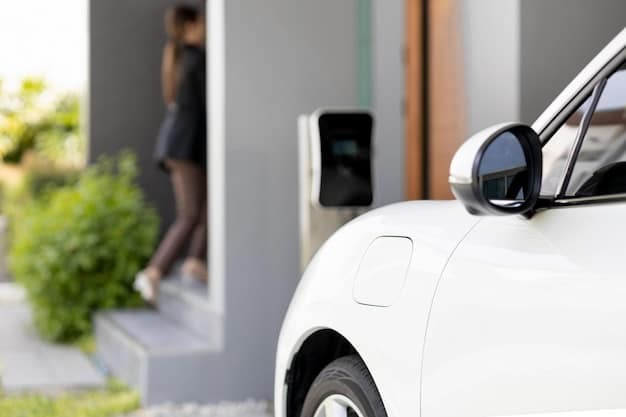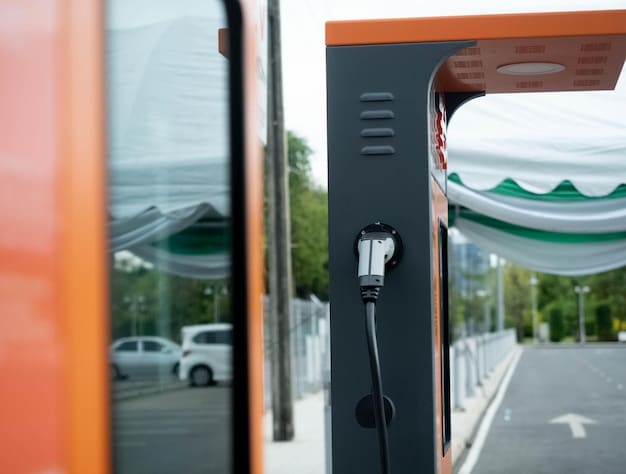Electric Vehicle Market Share Reaches Record 12% in the US

A new report indicates that electric vehicles (EVs) now account for a record 12% of all new car sales in the US, signaling a significant shift in the automotive market and increasing consumer adoption of electric mobility.
The latest Electric Vehicle Market Share Report: Electric Vehicles Now Account for 12% of All New Car Sales in the US – A New Record reveals a major milestone for EV adoption, showcasing the growing popularity and acceptance of electric cars among American consumers.
Electric Vehicle Sales Surge in the US
The United States is witnessing an unprecedented surge in electric vehicle sales. Recent data indicates a significant uptick in EV adoption rates, driven by various factors including environmental concerns, advancements in battery technology, and attractive government incentives. This section delves into the specifics of this growth, examining the numbers, the contributing factors, and the implications for the automotive industry.
Key Growth Drivers
Several factors have contributed to the recent surge in electric vehicle sales. Government incentives play a crucial role in making EVs more affordable for consumers. Technological advancements have also extended the range and reduced the charging times of electric cars, making them more practical for daily use.
Regional Variations
While the overall trend is positive, electric vehicle adoption rates vary significantly across different regions of the United States. States with more progressive environmental policies and higher incentives tend to have higher EV market shares. Urban areas, with greater access to charging infrastructure, also show stronger adoption rates compared to rural regions.
- Government incentives and tax credits
- Advancements in battery technology
- Growing awareness of environmental issues
- Expansion of charging infrastructure
The increase in electric vehicle sales is a testament to the evolving preferences of consumers and the concerted efforts of automakers and policymakers to promote sustainable transportation.
Breaking Down the 12% Market Share
Achieving a 12% market share is a significant milestone for electric vehicles in the US. This section provides a detailed breakdown of this figure, looking at the specific brands and models that are driving the growth, and examining the demographic trends among electric vehicle buyers. Understanding the composition of this market share is crucial for forecasting future trends and tailoring strategies for further adoption.

Top Performing Brands
Certain brands have consistently led the charge in electric vehicle sales. Tesla remains the dominant player, but other automakers are rapidly catching up with their own electric offerings. Brands like Ford, General Motors, and Hyundai have introduced popular electric models that are resonating with consumers.
Popular Models
The success of specific models has also contributed to the overall market share. The Tesla Model 3 and Model Y continue to be top sellers, but other models like the Ford Mustang Mach-E, Chevrolet Bolt, and Hyundai Kona Electric are also gaining traction.
The 12% market share represents a diverse mix of brands and models, indicating a healthy and competitive electric vehicle market.
The Impact of Government Policies and Incentives
Government policies and incentives play a pivotal role in shaping the electric vehicle market. This section examines the various federal, state, and local policies that are designed to encourage EV adoption. We will also analyze the effectiveness of these incentives and their impact on consumer behavior and market dynamics.
Federal Tax Credits
The federal government offers tax credits to eligible electric vehicle buyers, providing a significant financial incentive. These credits can reduce the upfront cost of purchasing an EV, making it more accessible to a broader range of consumers. The details and eligibility criteria for these credits are subject to change, so it’s important to stay updated on the latest regulations.
State-Level Incentives
In addition to federal incentives, many states offer their own set of rebates, tax credits, and other benefits to electric vehicle owners. These state-level incentives can vary widely, creating different levels of EV adoption across the country.
- Federal tax credits for EV purchases
- State-level rebates and tax incentives
- Charging infrastructure development programs
- Emission standards and regulations
Government policies and incentives are instrumental in overcoming the initial barriers to EV adoption and driving the transition towards sustainable transportation.
Infrastructure Development: Charging Ahead
The availability of charging infrastructure is a critical factor in the widespread adoption of electric vehicles. This section explores the current state of charging infrastructure in the US, examining the different types of charging stations, the geographical distribution of charging points, and the challenges and opportunities in expanding the charging network.

Types of Charging Stations
There are three main types of charging stations: Level 1, Level 2, and DC fast chargers. Level 1 chargers use a standard household outlet and provide the slowest charging speed. Level 2 chargers require a dedicated 240-volt circuit and offer much faster charging. DC fast chargers are the most powerful, providing the quickest charging times for compatible vehicles.
Geographical Distribution
The distribution of charging stations is uneven across the United States. Urban areas and states with high EV adoption rates tend to have more comprehensive charging networks. Rural areas, however, often lack sufficient charging infrastructure, which can hinder EV adoption.
Expanding the charging infrastructure is essential to alleviate range anxiety and encourage more consumers to switch to electric vehicles.
Consumer Perception and Adoption Barriers
Understanding consumer perception is crucial for addressing the barriers to electric vehicle adoption. This section examines the factors that influence consumer attitudes towards EVs, including concerns about range, charging time, cost, and vehicle performance. We will also explore strategies to overcome these barriers and promote wider adoption.
Range Anxiety
Range anxiety, the fear of running out of battery power while driving, is a major concern for many potential EV buyers. Automakers are addressing this issue by increasing the range of electric vehicles and developing more efficient battery technologies.
Charging Time
The time it takes to charge an electric vehicle is another barrier to adoption. While DC fast chargers can provide a significant charge in a short amount of time, they are not as readily available as Level 2 chargers. Reducing charging times and expanding the availability of fast-charging stations is crucial for improving the convenience of EV ownership.
- Addressing range anxiety through technological advancements
- Reducing charging times with faster charging infrastructure
- Lowering the upfront cost of EVs with incentives
- Educating consumers about the benefits of electric vehicles
Overcoming consumer perception and addressing the barriers to adoption are essential for realizing the full potential of the electric vehicle market.
Future Trends and Projections
The electric vehicle market is evolving rapidly, with new technologies, models, and policies constantly emerging. This section provides insights into the future trends and projections for the EV market in the US, examining the factors that are expected to drive growth and the potential challenges that lie ahead.
Technological Advancements
Ongoing advancements in battery technology are expected to further improve the range, charging time, and cost of electric vehicles. Solid-state batteries, for example, promise to offer higher energy density and greater safety compared to traditional lithium-ion batteries.
Policy Developments
Government policies and regulations will continue to play a significant role in shaping the electric vehicle market. The Biden administration has set ambitious goals for EV adoption and is investing heavily in charging infrastructure and battery manufacturing.
The future of the electric vehicle market in the US is bright, with significant growth potential driven by technological advancements, policy developments, and increasing consumer demand.
| Key Point | Brief Description |
|---|---|
| 📈 Record Market Share | EVs now account for 12% of new car sales in the US. |
| ⚡️ Government Incentives | Federal and state policies boost EV affordability. |
| 🔋 Infrastructure Growth | Expanding charging networks are crucial for wider adoption. |
| 🌿 Environmental Concerns | Rising environmental awareness drives consumer demand for EVs. |
FAQ
▼
Electric vehicles now account for 12% of all new car sales in the United States, marking a new record for EV adoption.
▼
Key drivers include government incentives, technological advancements in battery technology, and increasing environmental awareness among consumers.
▼
Tesla remains the dominant player, but brands like Ford, General Motors, and Hyundai are gaining significant traction with their EV offerings.
▼
Government policies, such as federal tax credits and state-level incentives, play a crucial role in making EVs more affordable and accessible to consumers.
▼
Challenges include range anxiety, charging time, the upfront cost of EVs, and the need for more extensive charging infrastructure, especially in rural areas.
Conclusion
The recent Electric Vehicle Market Share Report highlights the significant progress in electric vehicle adoption in the US, with EVs now representing 12% of new car sales. This milestone underscores the growing consumer confidence in electric mobility and the effectiveness of government policies and technological advancements in driving the transition towards a sustainable transportation future.





